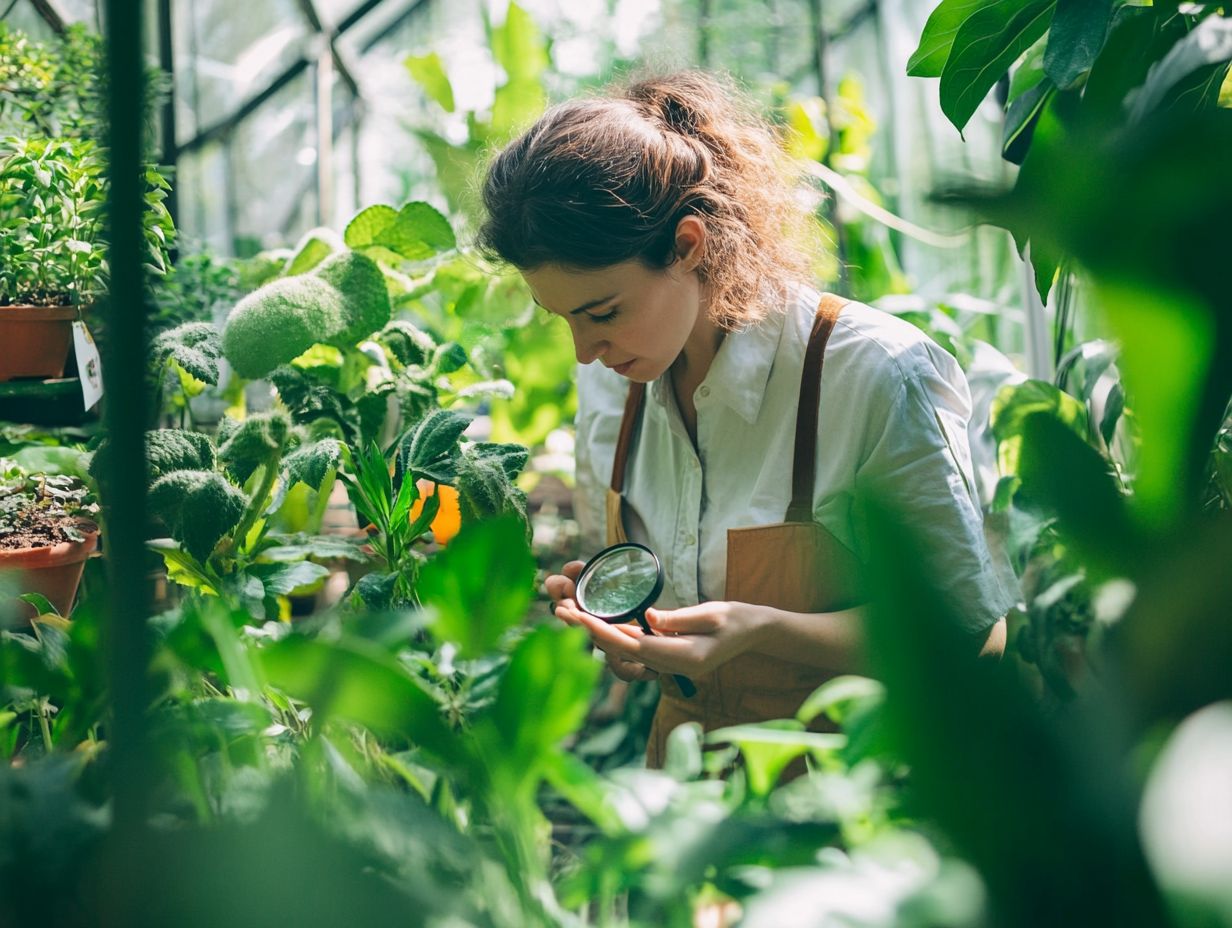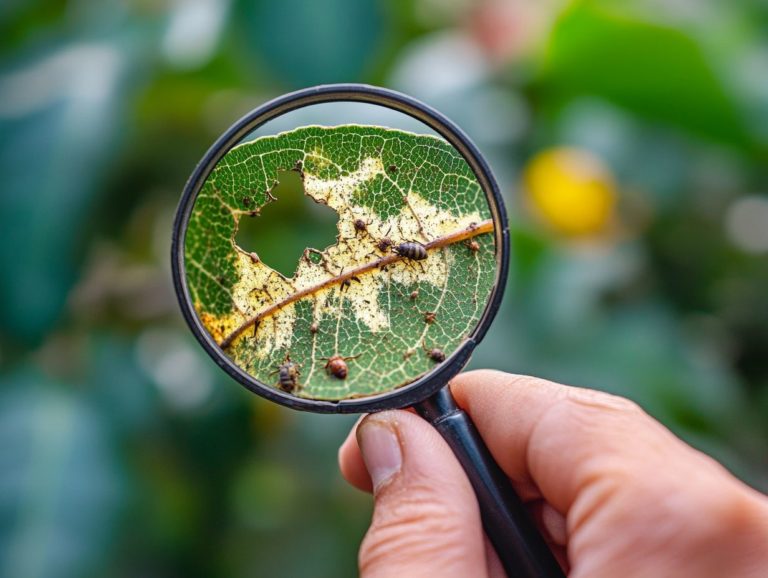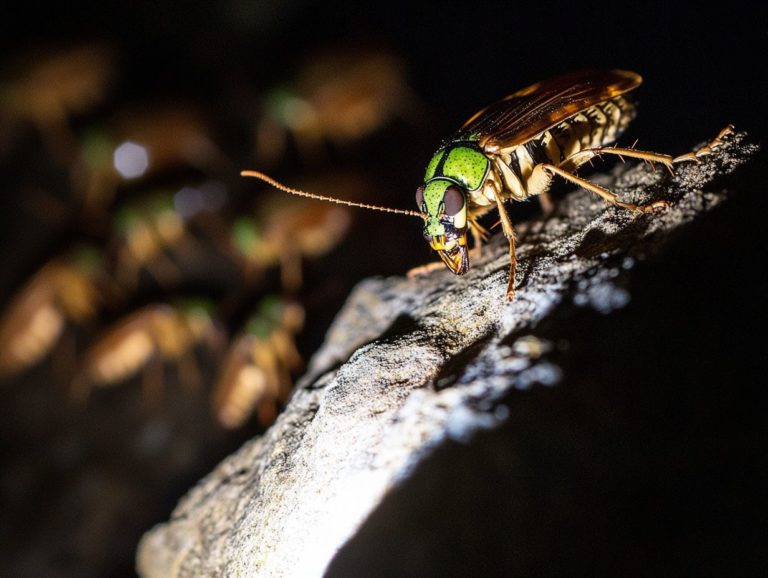5 Best Practices for Greenhouse Pest Management
Maintaining a thriving greenhouse is both an art and a science, especially when managing pests. Effective pest management protects your plants and fosters a healthier environment.
You re about to discover five simple practices that will revolutionize your pest management! From regular monitoring to using natural controls, these strategies will safeguard your greenhouse and boost your gardening success.
Jump in now to unlock the secrets of thriving plants!
Contents
- Key Takeaways:
- 1. Identify and Monitor Pests Regularly
- 2. Implement Good Sanitation Practices
- 3. Use Biological Controls
- 4. Rotate Crops and Practice Companion Planting
- 5. Utilize Organic Pest Control Methods
- What Are the Most Common Greenhouse Pests and How to Identify Them?
- How Can Regular Monitoring Help with Pest Management?
- What Are the Benefits of Good Sanitation Practices in Greenhouses?
- How Can Biological Controls Help with Pest Management?
- What Are the Benefits of Crop Rotation and Companion Planting in Greenhouse Pest Management?
- What Are Some Effective Organic Pest Control Methods for Greenhouses?
- Frequently Asked Questions
- Curious about the top 5 practices for managing pests in your greenhouse?
- How does proper sanitation help with greenhouse pest management?
- Why are natural pest fighters important in greenhouse pest management?
- How does crop rotation help with greenhouse pest management?
- Why is regular monitoring necessary for greenhouse pest management?
- How does proper plant nutrition play a role in greenhouse pest management?
Key Takeaways:

1. Identify and Monitor Pests Regularly
Regularly tracking pests is crucial for healthy plants and preventing outbreaks. This proactive approach allows you to act quickly and protect your crops.
Use simple ways to spot pests, like visual checks and sticky traps. These methods help you find pests early before they become a bigger problem.
By making regular observations, you can see how pest numbers change with environmental conditions like temperature and humidity. Keeping records of your findings helps you make better decisions for your greenhouse.
2. Implement Good Sanitation Practices
Good sanitation in your greenhouse creates a clean space that lowers pest and disease risks. This promotes healthier plants and effective pest control.
Set up a cleaning schedule and focus on removing debris that attracts pests. Regular cleaning reduces organic waste and helps prevent harmful pathogens.
By adopting these clean-up practices, you can combine them with other pest prevention methods, like crop rotation. Additionally, consider exploring 5 ways to keep your garden pest-free. These strategies improve soil health and create a stronger ecosystem for your plants.
3. Use Biological Controls
Use biological controls in your greenhouse. This lets you harness beneficial insects and natural deterrents to manage pests effectively.
Consider introducing ladybugs and predatory mites. These little heroes play crucial roles in keeping harmful pests like aphids and spider mites at bay. By integrating these natural predators into your pest management strategies, you can cultivate a balanced ecosystem that not only tackles current infestations but also prevents future outbreaks.
This method is key to successful pest management! It extends beyond immediate control to establish long-term solutions that promote crop health. Incorporating beneficial insects preserves biodiversity, which is essential for healthy crop growth, creating an environment where both plants and pest populations can coexist in harmony.
4. Rotate Crops and Practice Companion Planting

Implementing crop rotation and practicing companion planting are essential practices in greenhouse management that significantly enhance your pest management strategies. For those in colder climates, considering 5 techniques for winter pest management can further disrupt the life cycles of pests and foster a balanced ecosystem, setting the stage for success.
When you alternate different crops in a planned sequence, you naturally impede pest populations. Many pests thrive on specific plants. This practice not only breaks their life cycles but also enriches your soil s nutrient profile, making it healthier for future plantings.
Incorporating companion planting techniques where you pair specific plants to deter pests or attract beneficial insects further amplifies this protection. For example, pairing marigolds with vegetable crops can repel nematodes, while basil attracts pollinators and keeps flies at bay.
These synergistic practices lead to healthier plants while promoting a sustainable approach to pest management. This results in higher yields and resilient ecosystems.
5. Utilize Organic Pest Control Methods
Utilizing organic pest control methods ensures you comply with pesticide safety regulations and embraces a sustainable approach to pest management. This strategy protects beneficial insects and enhances crop health.
This holistic approach helps maintain a balanced ecosystem within your greenhouse while effectively combating common pests like aphids, whiteflies, and fungus gnats. For example, introducing beneficial predators such as ladybugs can lower aphid populations dramatically. Additionally, consider implementing 5 effective pest management tips for winter to enhance your pest control strategies. Sticky traps can control whiteflies and monitor their activity.
Organic pesticides like neem oil and insecticidal soap offer natural alternatives that disrupt pest life cycles without harming surrounding wildlife. By adopting these methods, you cultivate healthier plants and boost your yields, creating a more productive growing environment.
What Are the Most Common Greenhouse Pests and How to Identify Them?
Understanding common greenhouse pests is essential for an effective pest management strategy. Identifying pests like aphids, whiteflies, and fungus gnats allows you to implement 5 strategies for managing pests in containers in a timely and efficient manner.
These pests can greatly affect plant health by feeding on sap, transmitting diseases, or creating large populations that stress your plants. For instance, aphids are tiny, soft-bodied insects that can appear in shades of green, yellow, or black, often clustering on new growth. Their rapid life cycle leads to stunted plant growth and decreased yields if left unchecked.
Whiteflies are another concern. These small, white-winged insects reproduce quickly and can cause leaf discoloration and wilting. To stay ahead of these pests, monitor your foliage regularly for signs of infestation. Watch for sticky residue or discolored leaves. This proactive approach allows you to act swiftly, preventing severe damage to your plants.
How Can Regular Monitoring Help with Pest Management?
Regular monitoring is essential for effective pest management. It enables you to detect pest populations and assess potential issues before they escalate into serious problems. This proactive approach combines visual inspections and trap setups, providing you with valuable data on pest behavior and population dynamics.
When you conduct visual inspections consistently, you’re not just identifying pests. You’re also gauging the extent of any infestations, which allows for more targeted interventions. Meanwhile, strategically placed traps add another layer of watching, capturing pest specimens and revealing their movement patterns.
By maintaining a consistent monitoring routine, you can make informed decisions that enhance your pest management strategies. This effectively reduces the risk of crop damage and promotes healthier yields.
What Are the Benefits of Good Sanitation Practices in Greenhouses?

Implementing robust sanitation practices in your greenhouse brings a wealth of benefits. These include enhanced disease prevention, minimized pest issues, and the cultivation of healthy plants ultimately leading to better crop yields.
By ensuring that surfaces are consistently cleaned and disinfected, you can substantially reduce the presence of pathogens. Swiftly removing plant debris further limits pest problems.
Maintaining a regularly sanitized atmosphere supports the health of your plants. It also nurtures beneficial insects and tiny organisms that help plants grow, which are vital for a balanced ecosystem. This makes sanitation an essential element of effective greenhouse management.
How Can Biological Controls Help with Pest Management?
Biological controls enhance your pest management strategies in greenhouses. They leverage beneficial insects to regulate pest populations naturally. This approach reduces your reliance on chemical interventions while fostering ecological balance.
Ladybugs love eating aphids. They are vital for keeping your plants healthy. Then there are lacewing larvae, which actively target pests like spider mites and whiteflies, effectively diminishing their numbers before they wreak havoc on your crops.
By incorporating these natural predators into your greenhouse systems, you’re not just tackling infestations. You’re nurturing a resilient ecosystem that can self-regulate over time. This method brings exciting long-term benefits, enhancing soil health and biodiversity. Ultimately, it steers you toward sustainable agricultural practices and less dependence on synthetic pesticides.
What Are the Benefits of Crop Rotation and Companion Planting in Greenhouse Pest Management?
The benefits of crop rotation and companion planting in greenhouse pest management do more than just keep pests away. These practices elevate soil health, enhance plant care, and support seasonal adjustments for pest management strategies that promote sustainability.
By varying the crops in your greenhouse, you disrupt pest life cycles. This makes it harder for them to establish a foothold. This approach not only safeguards your plants but also promotes biodiversity, as a diverse array of crops can attract beneficial insects that serve as natural predators.
To effectively implement crop rotation, consider planning your crops by family. For instance, following heavy feeders with legumes can help restore nitrogen in the soil, ensuring optimal growth conditions.
Similarly, when it comes to companion planting, planting marigolds with tomatoes helps keep pests away and boosts overall growth. Integrating these strategies into your greenhouse not only enhances resilience against pests but also cultivates a healthier ecosystem within your growing space.
Start monitoring today! Embrace these practices and watch your plants thrive!
What Are Some Effective Organic Pest Control Methods for Greenhouses?
Wondering how to keep your greenhouse thriving while protecting our planet? Effective organic pest control methods harness natural deterrents and organic pesticides designed to safeguard plant health and minimize environmental impact.
Some of the most popular techniques include neem oil, insecticidal soaps, and essential oils. These methods are celebrated for their ability to target pests without harming beneficial insects. Neem oil, derived from the seeds of the neem tree, stops pests from growing and multiplying, offering lasting protection when applied correctly.
Insecticidal soaps suffocate soft-bodied insects, making them a safe choice for gardeners. Meanwhile, essential oils like peppermint and rosemary not only repel pests with their strong scents but also support your plants’ overall health.
These solutions can be easily integrated into a comprehensive pest management strategy, ensuring that your greenhouse gardening approach is eco-friendly and effective while promoting worker safety during pesticide application. For more insights, check out the 5 essential resources for pest management.
Frequently Asked Questions

Curious about the top 5 practices for managing pests in your greenhouse?
The top 5 practices for greenhouse pest management are:
- Proper sanitation
- Use of natural pest fighters
- Crop rotation
- Regular monitoring
- Proper plant nutrition
All of these are essential for effective pest control methods.
How does proper sanitation help with greenhouse pest management?
Keeping the greenhouse clean and free of debris reduces potential hiding spots and breeding grounds for pests. This leads to a decrease in their population and makes it easier to spot and control any remaining pests, especially when implementing top cold-climate pest management strategies.
Why are natural pest fighters important in greenhouse pest management?
Natural pest fighters, such as beneficial insects and predatory mites, help keep pest populations under control naturally. This reduces the need for chemical pesticides and supports a balanced ecosystem in your greenhouse.
How does crop rotation help with greenhouse pest management?
Crop rotation means switching out crops in different sections of the greenhouse. This practice prevents the build-up of pests that are specific to certain plants, helps maintain soil health, and avoids nutrient depletion.
Why is regular monitoring necessary for greenhouse pest management?
Regular monitoring allows growers to quickly identify any pest problems and take action before they escalate. It also helps spot any potential issues with plant health or environmental conditions that may attract pests.
How does proper plant nutrition play a role in greenhouse pest management?
Healthy, well-nourished plants are less likely to suffer from pest infestations. By providing proper nutrients, growers can help prevent pest problems and support overall plant health.
Don’t wait! Implement these organic pest control methods in your greenhouse today, along with ice-breaking tips for winter pest management, to protect your plants and the environment!






